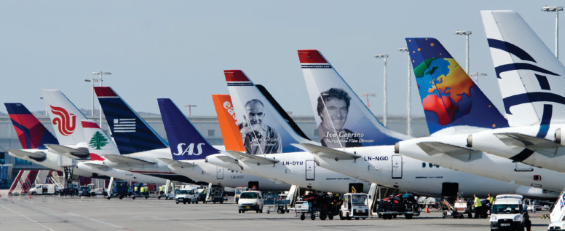Articles
| Name | Author | |
|---|---|---|
| CMS Integration with M&E Systems | Thanos Kaponeridis, President & CEO, AeroSoft Systems | View article |
| MRO Technology Innovations: using BOTS and HoloLens to change the way work is done | Arun Navneethakrishnan, Solution Advisory, Americas, Ramco Systems | View article |
| Aviation maintenance, the imperative to innovate | Wayne Enis, Director of Sales Engineering at Flatirons Solutions | View article |
| Tail planning to stay ahead of schedule | Andrew Stimpson, Solution Manager, Middle East, IFS | View article |
Tail planning to stay ahead of schedule
Author: Andrew Stimpson, Solution Manager, Middle East, IFS
SubscribeStaying Ahead of Schedule

Andrew Stimpson, Solution Manager for Aerospace & Defense at IFS explains how tail planning can enhance MRO and fleet management for airlines
A GROWTH BUSINESS MEANS GROWING CHALLENGES
Commercial aviation market figures are staggering. In its current outlook, Boeing predicts orders for nearly 40,000 new aircraft over the next 20 years valued at $5.9 trillion. Much of the boom in passenger demand and fleet expansion is being driven by airlines in the Middle East and Asia-Pacific, which are witnessing year-on-year air growth in passenger demand of over 10% – eclipsing the growth in demand of carriers in North America and Europe.
All airlines face pressure to increase efficiency by sweating airframe assets. But it’s a complex issue – how do planners optimize aircraft allocation while coping with unexpected operational changes and unscheduled maintenance? A typical airline will have an aircraft allocation team on this chore, spending some three to four hours to prepare a single one-day optimized plan. But tightly planned schedules can quickly be thrown out of kilter by last-minute changes. Add in weather, air¬port delays or engine failures and airline operations can soon become jeopardized. . Fortunately, there are new solutions that provide airline operators with a better way of working to combat aircraft planning and maintenance challenges as fleet schedules become more complex.
THE ELEMENTS OF PLANNING
The utilization and optimization of a fleet involves a number of interrelating factors which need to be balanced and reconciled to produce a cost and asset-efficient schedule. For example, long-term maintenance, destination-based constraints and aircraft restrictions need to be factored in to route scheduling, not to mention the unscheduled, short- and mid-term maintenance requirements that must also be managed compliantly. At the same time, elements such as fleet allocation, flight frequency and seat planning must be synchronized with crew rostering, ground support and equipment planning.
As more planes take to the skies and more routes are introduced, the optimization of an airline fleet quickly becomes too complex for traditional planning methods to handle.
THE TAIL PLANNING CHALLENGE
Any number of variables can impact fleet planning and cause major headaches for airlines. For a start, a fleet often contains aircraft of different ages and with variable capabilities in factors such as flight range, flight capacity and even class of travel. The maintenance requirements of each air¬craft will also differ at any point in time depending on the number of hours operated, landings made and the scheduled maintenance window available.
The lack of maintenance synchronization can cause a chain of disruptions, meaning air¬craft are unavailable for flights and adding to lost revenues. The effects of these delays flow down the network, beginning a costly snow¬ball effect of more delays or cancellations.


All airlines are susceptible to ‘unknown unknowns’. For example, the International Air Transport Association (IATA) estimated that the infamous 2010 Eyjafjallajökull volcano cost airlines £10m a day due to schedule disruptions. No amount of affordable planning or contingency can account for ‘acts of God’ or political disruption, but airlines can be better prepared for when these events happen in the future. When the unknown strikes, rescheduling an optimal assignment and maintenance schedule quickly becomes too large a task to be undertaken manually.
THE TAIL PLANNING CHECKLIST
Dynamic scheduling engine (DSE) is at the heart of airline operations. Tail Planning departments in large airlines can receive 150 change requests in a single day, and the solution’s work-flow management tool is key to help manage those in a sensible way. The solution keeps planners focused on dealing with the exceptions, rather than the whole schedule, which the DSE does for them.
The built-in business intelligence of the solution is vital. For example, airlines have a number of KPIs – including utilization, ground time and compliance. The ever-changing nature of the industry means using configuration capacity. Planning teams are being asked to do different things every day – the solution’s built-in configuration capacity copes with this.
Airlines also have strict SLAs (service level agreements). Every single maintenance event on any aircraft in a fleet is run through an SLA. Often there’s an optimum ‘sweet spot’ for regular maintenance, around which an airline can run everything. The solution has to be able to find that ’sweet spot’ or risk unsettling tightly-scheduled maintenance plans.
Then there are soft and hard rules and constraints to manage. An example of a hard constraint is airports that can’t manage aircraft that are too small for them, or flights to repair facilities that can’t handle it. But there are softer ones around ideal situations that can be broken. Here again the tail planning solution must be able to manage the hard with the soft.
NEW SOLUTIONS NOW PROVIDE AIRCRAFT PLANNING – FROM HEAD TO TAIL
Traditional tail planning software hasn’t always kept pace with this increasing growth and complexity. To avoid revenue lost through inefficient or delayed actions, airline operators need to look at new solutions which focus on the three key areas to take full advantage of the booming commercial industry.
1. Route efficiency
With aircraft capable of flying more routes than ever before, airlines and passengers are looking for more efficient air travel on both short- and long-range routes. Armed with an optimized tail planning solution, airlines can automatically determine which aircraft is best suited to fly a route by looking at the range and fuel efficiency of that aircraft – for example, using a newer, more fuel-efficient aircraft on a route, or vice versa, because of operation or maintenance needs. Airlines must also be able to analyze data to consider other aircraft type options if required – for example, comparing the cost of ground servicing an aircraft during a stopover.
2. Fleet Utilization
Tail assignment per route becomes significantly less of an operational management issue for the airline if all the individual and cumulative fleet constraints are reconciled by a single solution. The complexity of fleet commonality also becomes less of an issue as the solution should account for many more of the individual restrictions and requirements from each aircraft than a manual planner. This makes it easier to satisfy restrictions and create a plan that is viable for all aircraft, without having a negative impact on the payload or making adjust¬ments to the fleet.
3. Maintenance Planning
Maintenance planning must also be optimized by finding the best time slot for the airline, maintenance crew and aircraft. Factors such as hanger capacity, personnel availability and specific maintenance requirements of each aircraft must be considered and used to optimize the maintenance schedule with the flight schedule. Maintenance and flight planning have different priorities – maintenance means inactive aircraft while flight planners want as many planes in the air as possible.
THE WIDER BENEFITS
Solutions such as Tail Planning, Optimization and Assignment (TPOA) are able to combine strategic, optimized scheduling with real-time operational visibility to provide airlines with the ability to maximize aircraft allocation efficiency, support aircraft planning and optimally schedule maintenance events.
Thanks to this combination of intelligent operational tools, airlines can now make real-time data-driven decisions, responding to change and the unexpected faster and more effectively. Airlines need a solution today that will help them to reduce risk, increase ULR (ultra-long range) efficiency and improve fleet utilization and maintenance planning. TPOA does this while providing performance visibility needed to make continual improvements to efficiency, safety and customer satisfaction.
With this kind of solution, what used to take planners hours now takes minutes. Airlines and operators benefit from an automated solution that increases route efficiency, improves fleet utilization and optimizes maintenance planning. Having this level of organization will help airlines and operators stay one step ahead of competitors in the ever-growing global civil aviation market, by keeping fleets airborne, airline planners stress-free and customers satisfied.
A COMPETITIVE EDGE IN A BOOMING INDUSTRY
With passenger and airline growth showing no signs of slowing down, modernizing the allocation and optimization of aircraft within a complex fleet will only increase in importance. To meet this challenge, these new solutions have been developed to ensure the multiple elements of airline planning run smoothly together, and provide planners with instant readjustments when faced with disruption.
In the competitive world of commercial air travel, effective tail planning can provide airlines with an edge as they keep passengers happy and protect their bottom line. Failure to plan can leave airlines trailing in the wake of more organized carriers keeping up with the booming commercial aviation market.
Contributor’s Details
 Andrew Stimpson, Solution Manager, Middle East, at IFS
Andrew Stimpson, Solution Manager, Middle East, at IFSAndrew is responsible for managing IFS solution projects in the Middle East, and began with IFS in Australia in 2001. In his current role, Andrew is currently working as the Solution Manager for the implementation of the IFS solution within the greenfields engine overhaul site currently under construction by Emirates engineering. He is also Solution Manager for IFS Tail Planning Optimisation & Assignment in the Middle East.
IFS A&D

IFS develops and delivers enterprise software for the Aerospace and Defense (A&D) industry. IFS Applications supports full-spectrum enterprise, project and program-centric manufacturing and vendors serving the A&D sector; heavy, complex, and component maintenance; and repair and overhaul (MRO) for civil aviation, military and service providers, as well as line maintenance or at-platform/asset support. IFS customers in A&D include BAE Systems, Lockheed Martin, General Dynamics, SAAB, GE Aviation, HAL, and Emirates.
Comments (0)
There are currently no comments about this article.

To post a comment, please login or subscribe.